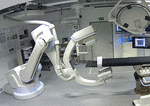Congress:
EuroSafe Imaging 2020
Keywords:
Not applicable, Dosimetric comparison, Dosimetry, Cone beam CT, Radioprotection / Radiation dose, Interventional vascular, Interventional non-vascular, Action 9 - Facilitation of research in advanced topics of radiation protection
Authors:
T. Russ, A. M. Abdelrehim, D. F. Bauer, S. Hatamikia, L. R. Schad, F. Zöllner, K. Chung
DOI:
10.26044/esi2020/ESI-05719
Background/introduction
Cone beam CT (CBCT) systems mounted on robotic C-arms enable the implementation of arbitrary scan trajectories. These can be exploited to actuate the source and detector around interfering equipment during interventions. Non-conventional acquisition orbits can provide comparable and in some cases even locally enhanced image quality while simultaneously increasing the flexibility of the interventional equipment and even reduce the exposure for patients and personnel. The inherent image quality alteration is heavily dependent on the utilized orbit geometry and may limit the performance of radiologists during image analysis. Simultaneous prediction of image quality and physical dose is thus necessary when optimizing tomosynthesis trajectories. For this task, we propose a prediction framework based on Monte Carlo simulations using the Geant4 Application for Tomographic Emission (GATE) [1]. Our framework accurately captures the physical processes inherent to the imaging process and includes a model of an interventional CBCT scanner (Artis Zeego, Siemens Healthineers, Forchheim, Germany), which is depicted in Figure 1.


